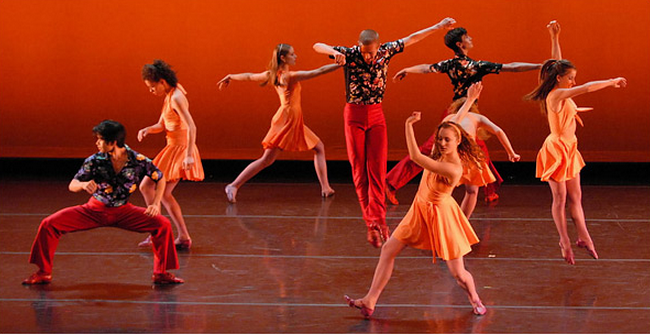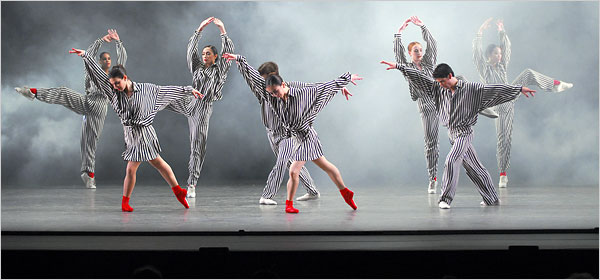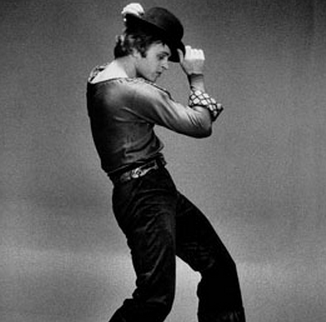I used to say that Twyla Tharp’s 1976 Push Comes to Shove is the ballet that made Baryshnikov an American. Its slinky displacements, Vaudevillian showmanship, and casual sexiness, were all buoyed by Joseph Lamb’s ragtime music. It’s uncanny how completely Misha took to this quintessentially American idiom, slipping between classical pirouettes, the isolations of jazz, and the de-centering of postmodern. Nothing in his Vaganova training could have prepared him for this role, yet he intuitively understood every shift deep in his bones. (Check out a clip here.)
But I also think that Misha helped make ballet American—for our generation—in other ways too. As director of American Ballet Theatre from 1980 to ’89, he commissioned Tharp often and invited some of her dancers to be company members. He also commissioned David Gordon, Mark Morris and Karole Armitage. Tharp’s In the Upper Room, to transcendent music by Philip Glass, premiered with her own group in 1986 and entered ABT’s rep in 88. Her Bach Partita and Sinatra Suite also premiered at ABT during that decade. Together Misha and Twyla built an American repertoire for American Ballet Theatre. In case you need reminding of how glorious Upper Room is, here’s a clip.
Yes, Yes, Lucia Chase had brought in the first American ballets— Eugene Loring’s Billy the Kid, Agnes de Mille’s Rodeo, and Jerome Robbins’ Fancy Free. (We were happily reminded of this at ABT’s 75th anniversary gala.) But there’s been a lot of Tudor, MacMillan, Fokine, and Ashton. I’m not saying I object, I’m just noticing that Misha’s reign embraced American dance artists. It’s a different time now, and I’ve enjoyed the full rep of ABT this season.
Of course another famous Russian had made ballet American for a previous generation. George Balanchine stretched the lines of ballet, sped up the allegro, and thrust his dancers into space. But Balanchine used mostly European and Russian composers, whereas Twyla went with Jelly Roll Morton, Randy Newman, and the Beach Boys.

Juilliard students in Deuce Coupe, 2007, photo by Nan Melville
Talking about the Beach Boys, Twyla’s Deuce Coupe (1973) was something of a precursor to Push in that it combined ballet steps with everyday gestures and social dance. In the original version she joined her own (post)modern dancers with the Joffrey company. (It’s interesting to note that Wayne McGregor’s latest work, which comes to the Park Avenue Armory in September, also mixes his own modern dancers of Random Dance with Paris Opera Ballet dancers.)
When Twyla made Push Comes to Shove for Baryshnikov, it had all the pyrotechnics he learned in his pure Russian training and his individual charm as a performer, but with a touch of insolence too. Think Marlon Brando in The Wild Ones or James Dean in Rebel Without a Cause. Adding a dollop of witty playfulness makes her ballets less brooding and more Dionysian.

ABT dancers in the finale of In the Upper Room, photo by Nan Melville
What’s American too is the melting-pot finales in Tharp’s ballets like Push, Deuce Coupe, and Upper Room. She throws everything and everybody together in a wash of onstage anarchy, all repeating phrases they’ve done before but newly recycled because everyone’s onstage, all peacefully co-existing. In Push it was Vaudevillians and classicists, Russians and Americans. In Deuce Coupe it was ballet dancers and modern dancers, rock and classical. In Upper Room, it’s the stompers, the bookend girls, the pointe shoes girls and everyone else. These endings sometimes make me cry because they speak of active acceptance of all kinds of people—still a challenge in our American democracy. These big, unruly, energetic free-for-alls are Twyla’s vision of harmony…an onstage, perpetual-motion rainbow.
Featured Uncategorized 3
